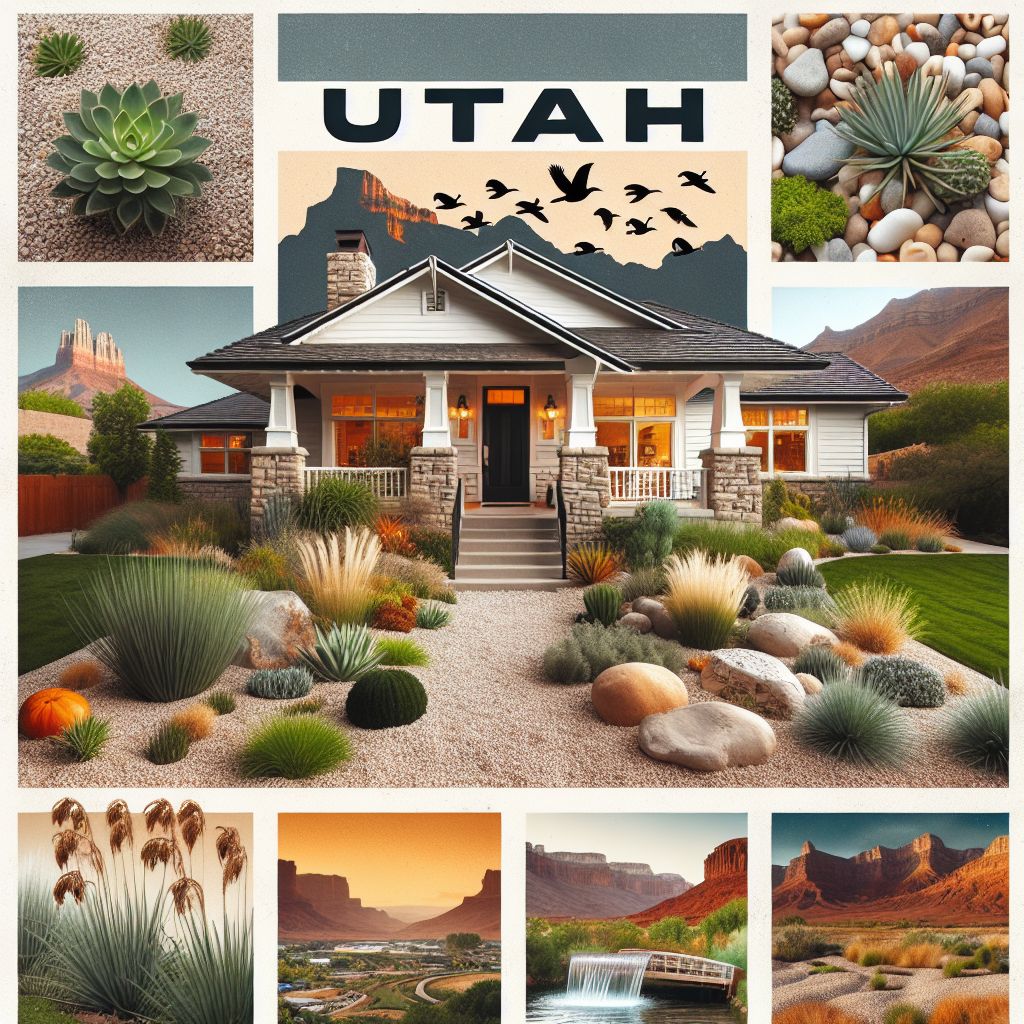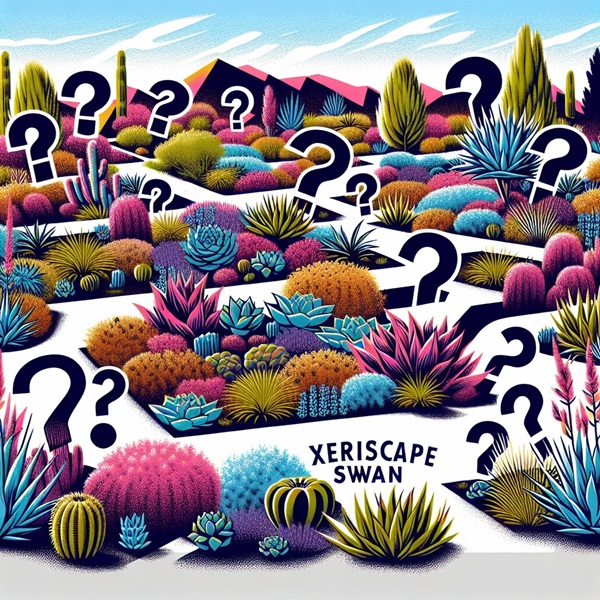
Key Takeaways
- Xeriscaping in Utah HOAs is a balancing act between water conservation and compliance with local rules.
- Drought-tolerant native plants are the stars of
, with Utah’s climate providing the perfect stage. - Understanding your HOA’s guidelines is crucial before you start digging into xeriscaping.
- Designing a xeriscape requires knowledge of plant needs, soil conditions, and local climate patterns.
- With the right approach, xeriscaping can lead to significant water savings and a stunning, low-maintenance yard.
Thriving with Less Water: The Beauty of Xeriscaping
Imagine your garden blooming with vibrant colors, buzzing with life, and all the while, it’s conserving water. This isn’t just a dream—it’s xeriscaping, and it’s perfect for Utah’s dry climate. But what exactly is xeriscaping? It’s a landscaping philosophy that uses drought-resistant plants and efficient irrigation to create a sustainable and beautiful garden that requires less water and maintenance.
Know Your Ground: Understanding Utah’s Unique Climate
Before diving into the world of xeriscaping, let’s talk about Utah’s climate. It’s unique, with hot summers, cold winters, and less rainfall than many other places. This means the plants we choose for our gardens need to be tough enough to thrive with less water. And that’s where xeriscaping shines—it’s all about choosing the right plants for our environment.
Xeriscape Essentials: Crafting Your Low-Water Eden
Building Blocks for Xeriscaping in Utah
So, you’re ready to start xeriscaping. Where do you begin? First, assess your space. How much sun does it get? What’s the soil like? These factors will determine which plants will thrive in your garden. Remember, the goal is to use water wisely, which starts with understanding the needs of your plants and your land.
Plants that Flourish with Minimal H2O
Choosing the right plants is the heart of xeriscaping. In Utah, you’ll want to look for species that are native to the area or adapted to dry conditions. Think of Utah’s state flower, the Sego Lily, or the hardy Russian Sage. These plants are accustomed to the climate and will need less water than non-native, thirstier varieties.
Here are some top picks for your Utah xeriscape:
- Perennials: Yarrow, Penstemon, and Coreopsis
- Shrubs: Utah Serviceberry, Rabbitbrush, and Manzanita
- Trees: Pinyon Pine, Utah Juniper, and Gambel Oak
Design Techniques for Maximum Impact
Design is more than just aesthetics in xeriscaping—it’s about functionality. Grouping plants with similar water needs together makes irrigation more efficient. Creating zones in your garden can help you manage water use effectively. And don’t forget about mulch—it helps retain soil moisture and reduces water evaporation.
Weathering the Seasons: Year-Round Strategies
Utah’s seasons can be extreme, but with xeriscaping, your garden can be a year-round oasis. In the heat of summer, your drought-resistant plants will stand strong, and in the chill of winter, they’ll rest and prepare for another vibrant bloom. The key is to select plants not just for their ability to withstand dry conditions, but for their resilience to the cold snaps that Utah can sometimes experience.
Desert Blooms: Utah’s Exclusive Plant Palette
Utah’s plant palette is like a treasure trove of hardy gems. It includes plants that have adapted to the desert environment, meaning they’re naturally efficient at using water and thriving in the heat. By choosing from this palette, you’re not only ensuring your garden’s success but also promoting local biodiversity.
Nurturing Native Plants in Utah’s Arid Conditions
Native plants have a natural advantage—they’ve been perfecting their survival skills in Utah’s climate for centuries. By nurturing these plants in your garden, you’re working with the environment, not against it. This means less work for you and a healthier, happier garden that’s in sync with the surrounding ecosystem.
The Beauty of Drought-Resistant Blooms
Don’t think for a second that choosing drought-resistant plants means sacrificing beauty. Flowers like the vibrant Indian Blanket or the delicate Evening Primrose can bring a splash of color to your xeriscape. Shrubs like the Blue Sage add texture and depth, while ornamental grasses like Blue Grama wave gracefully in the breeze.
Planning for Perfection: The Practicalities of Xeriscaping
Planning your xeriscape is an exciting process, but it’s also a time to be practical. Think about the layout of your garden, the paths you’ll walk, and the areas where you’ll relax. Consider the views from your windows and where the shadows fall. Each of these elements plays a part in creating a xeriscape that’s not only water-wise but also a joy to use and view.
Water Requirements: Quenching Your Garden’s Thirst
Even xeriscaped gardens need water—just less of it. When you do water, do it deeply and infrequently to encourage deep root growth. This makes your plants more resilient and reduces the need for watering. Drip irrigation is a fantastic way to deliver water directly to the roots of your plants, where it’s needed most.
Finding the Right Spot: Sunlight and Your Plants
Every plant has its own sunlight preferences. Some bask in the full glare of the sun, while others prefer a bit of shade. When you’re planning your xeriscape, position your plants where they’ll be happiest. Full-sun plants should be placed in the open, while those that need protection can be nestled under the dappled shade of a tree or beside a sun-blocking structure.
- Full Sun: Coneflowers, Yucca, and Sedum
- Partial Shade: Columbine, Fernbush, and Goldenrod
- Full Shade: Mahonia, Coral Bells, and Snowberry
Soil Secrets: The Foundation of a Xeriscape Garden
Remember, good soil is the lifeblood of your garden. In Utah, soils can range from sandy to clay-heavy, and each type has its own quirks. Sandy soil drains quickly but doesn’t hold nutrients well, while clay soil holds water but can become compacted. Amending your soil with organic matter can improve its structure and water-holding capacity, setting the stage for a successful xeriscape.
Test your soil to understand its texture and nutrient content. This will guide you in selecting the right plants and amendments. If you’re unsure how to test your soil, local nurseries or extension services can help.
Plant Longevity: Selecting for Sustainability
When you choose plants for your xeriscape, think long-term. Perennial plants that come back year after year are a great investment. They establish deep root systems that make them more drought-tolerant and reduce the need for replacement. Plus, perennials often become more robust and beautiful with each passing year.
Calculation of Costs: Affordability Meets Ecology
Xeriscaping is not only eco-friendly, it’s also cost-effective. While there’s an initial investment for plants and materials, the ongoing savings are significant. You’ll spend less on water, fertilizers, and maintenance. Over time, these savings add up, making xeriscaping a smart financial choice as well as an ecological one.
Home Turf: Understanding Local Xeriscaping Guidelines
Before you break ground on your xeriscape, you need to understand your local HOA’s rules. These guidelines can dictate what you can plant and where you can plant it. They’re in place to ensure a cohesive look within your community, but they also need to allow for water conservation efforts. Make sure to review your HOA’s guidelines carefully to avoid any surprises down the road.
Linking Local Flora to Your Landscape Design
Let’s bring our focus back to the plants that can make your Utah xeriscape truly local. Using native plants not only supports the local ecosystem but also gives your garden a sense of place. Think about incorporating plants like the Utah
When you choose local plants, you’re also choosing to welcome local wildlife. Birds, bees, and butterflies that are native to Utah will be more likely to visit your garden, bringing it to life with their presence. It’s a win-win situation where you get to enjoy a beautiful, lively garden while supporting the environment.
Most importantly, when you’re planning your xeriscape, consider the visual impact. Native plants come in all shapes, sizes, and colors, so you can create a stunning tapestry that changes with the seasons. From the fiery reds of the Autumn Sage to the soothing greens of the Pinyon Pine, your garden will be a feast for the eyes all year round.
Xeriscaping Data Snapshot: A Clear Comparison
Now, let’s lay out the facts with some numbers. Xeriscaping isn’t just about making a beautiful garden; it’s also about practical benefits. To help you visualize the advantages, I’ve put together a data table that compares traditional landscaping with xeriscaping in Utah.
Plants & Features at a Glance
| Feature | Traditional Landscaping | Xeriscaping |
|---|---|---|
| Water Usage | High | Low |
| Maintenance | Regular mowing, fertilizing, and pruning | Minimal pruning and occasional weeding |
| Cost Over 5 Years | Higher due to water and maintenance | Lower due to reduced water and maintenance needs |
| Plant Diversity | Often limited to non-native species | Diverse, including many native species |
| Environmental Impact | Greater water consumption and chemical use | Conserves water and reduces chemical use |
Here is a data table with 3 columns and 5 rows on the topic of Utah HOA Xeriscaping Guide: Allowed Plants & Landscaping Rules, with references as numbers in the table separated by a comma and space:
Example HOA Xeriscape Rules In Utah
| Allowed Landscaping Elements | Prohibited Landscaping Elements | HOA Xeriscaping Rules |
|---|---|---|
| Native, drought-tolerant plants 2 4 | Thirsty grass lawns covering more than 50% of property 1 | HOAs cannot prohibit homeowners from installing water-wise landscaping 1 |
| Trees, shrubs, and groundcover adapted to Utah climate 2 4 | Gravel or rock covering more than 50% of property 2 | HOAs can require up to 50% of property to be covered in non-water-wise landscaping1 |
| Edging made of metal or composite materials 2 | Permanent lighting without prior HOA approval 2 | Homeowners must obtain HOA approval for xeriscaping projects 2 |
| Brown or black wood mulch 2 | Unapproved fencing materials or designs 2 | HOAs may have specific requirements or permits needed for xeriscaping 2 4 |
| Board-approved park strip designs2 | Unapproved structures like pools, firepits, or water features2 | Xeriscaping must comply with HOA design guidelines2 |

FAQ – Your Xeriscaping Queries Answered
As you embark on your xeriscaping journey, you might have some questions. Let’s tackle a few common ones to give you a clearer path forward.
What Makes a Plant Ideal for Utah Xeriscaping?
An ideal plant for Utah xeriscaping is one that’s drought-tolerant, native or adapted to the local climate, and can thrive with minimal care. These plants have developed strategies to survive Utah’s hot, dry summers and cold winters. They often have deep root systems, waxy or hairy leaves to reduce water loss, and a natural resilience to local pests and diseases.
Because of these traits, they require less water and fewer resources to maintain. This makes them perfect for a xeriscape where the goal is to create a sustainable, low-water-use garden. So, when selecting plants, look for these water-wise champions that are built to thrive in Utah’s unique environment.
How Much Could I Really Save by Xeriscaping?
Switching to xeriscaping can lead to substantial savings, especially when it comes to water bills. In Utah, where water is a precious resource, reducing your garden’s water needs can make a big difference. On average, you can expect to save anywhere from 30% to 60% on your water bill, depending on the size of your garden and the plants you choose.
But the savings don’t stop there. You’ll also spend less time and money on maintenance, such as mowing, fertilizing, and dealing with pests. Over time, these savings add up, making xeriscaping a smart choice for your wallet and the planet.
Is Xeriscaping a Fit for Every Type of Property?
Xeriscaping can be adapted to almost any type of property, from small urban yards to sprawling rural estates. The key is to tailor the design to the space you have. Even if you’re working with a compact area, you can create a lush, water-wise garden with careful plant selection and strategic design. For larger properties, xeriscaping can help manage water usage across expansive gardens, making it a practical and beautiful landscaping solution.
Therefore, whether you have a tiny patio or acres of land, xeriscaping is a flexible and adaptable approach to gardening that can work for you.
Can Xeriscaping Support Wildlife and Biodiversity?
Absolutely! Xeriscaping, especially when using native plants, can create a habitat for local wildlife. Birds, butterflies, and bees are all attracted to the native flowers and shrubs that thrive in a xeriscape. By providing food, shelter, and nesting sites, your garden becomes a living ecosystem that supports biodiversity.
Moreover, by reducing the use of chemicals and fertilizers, you’re creating a safer environment for these creatures. A xeriscape is not just a garden; it’s a sanctuary for the local wildlife that shares our space.





Leave a Reply